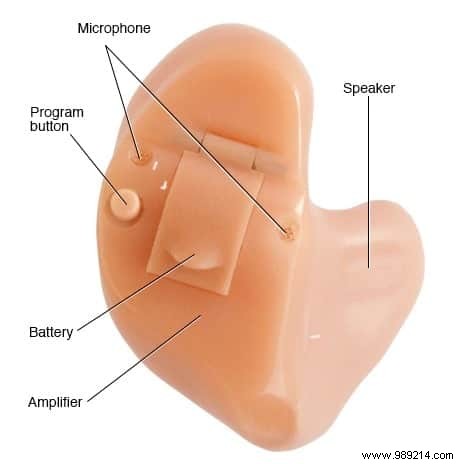As we age, the hair cells that line the inner ear become less efficient. It can also be the result of a pathology or an accident. This loss of efficiency results in a slight or severe decrease in hearing. To remedy this problem, there are technologies that can partially restore people's hearing by collecting and amplifying surrounding sounds in the form of hearing aids.
A hearing aid is a small electronic device that you wear in or behind your ear. It amplifies sound so that a person with hearing loss can hear, communicate and participate more fully in daily activities. Hearing aids can help people hear better in both quiet and noisy situations. However, only one in five people who would benefit from a hearing aid use it on a daily basis.
All hearing aids use the same basic components to transport environmental sounds into the ear and amplify them. Most hearing aids are digital and all are powered by either a traditional battery or a rechargeable battery.
Small microphones pick up sounds from the environment. A computer chip with an amplifier converts the incoming sound into digital code. It analyzes and adjusts sound based on your hearing loss, listening needs and the level of sounds around you. The amplified signals are then converted back into sound waves and transmitted to your ears through speakers.
Hearing aids are primarily useful for improving aural and speech understanding in people who have hearing loss resulting from damage to the small sensory cells in the inner ear, called hair cells. This type of hearing loss is called sensorineural hearing loss. Damage can occur as a result of illness, aging, or injury from noise or certain medications.

A hearing aid amplifies sound vibrations entering the ear. The surviving hair cells pick up the strongest vibrations and convert them into neural signals that are transmitted to the brain. The more hair cells are damaged, the more severe the hearing loss and the greater the amplification of the hearing aid needed to compensate for the difference.
As such, many platforms (even if they do not replace a specialist), such as Phonak Hearing Test, allow you to assess your hearing. However, there are practical limits to the amount of amplification a hearing aid can provide. Moreover, if the inner ear is too damaged, even strong vibrations will not be converted into neural signals. In this situation, a hearing aid would be ineffective.
Behind-the-ear (BTE) hearing aids consist of a sturdy plastic case worn behind the ear and connected to a plastic tip that fits inside the outer ear. The electronic parts are kept in the case behind the ear. Sound travels from the hearing aid through the earmold and into the ear. BTE devices are used by people of all ages for mild to profound hearing loss.
In-the-ear (ITE) devices fit completely inside the outer ear and are used for mild to severe hearing loss. The housing containing the electronic components is made of hard plastic. Some ITE devices may have certain additional features installed, such as a specific coil. It's a small magnetic coil that allows users to receive sound through the hearing aid's circuitry, rather than through its microphone.
This makes it easier to listen to conversations on the phone. A telecoil also helps people hear in public facilities that have installed special public address systems, called induction loop systems. Induction loop systems can be found in many churches, schools, airports and auditoriums. ITE devices are generally not worn by young children, as the cases need to be replaced often as the ear grows.
Canal devices fit into the ear canal and come in two styles. The canal device (ITC) is designed to adapt to the size and shape of a person's ear canal. A full canal device (CIC) is virtually hidden in the ear canal. Both types are used for mild to moderately severe hearing loss.
Because they are small, ITCs/CICs can be difficult to fit and remove. In addition, channel aids have less space available for batteries and additional devices. They are generally not recommended for young children or people with severe to profound hearing loss, as their small size limits their power and volume.
Analog devices convert sound waves into electrical signals, which are amplified. Analog/adjustable hearing aids are custom designed to meet the needs of each user. The aid is programmed by the manufacturer according to the specifications recommended by your audiologist. Analog/programmable devices have more than one program or setting.
An audiologist can program the device using a computer, and you can modify the program for different listening environments — from a small, quiet room to a crowded restaurant to large open areas, such as a theater or a stadium. Analog/programmable devices can be used in all types of hearing aids. They are generally less expensive than digital.
Digital devices convert sound waves into digital codes, similar to the binary code of a computer, before amplifying them. Since the code also includes information about the pitch or volume of a sound, the aid can be specially programmed to boost certain frequencies more than others. Digital devices give an audiologist more flexibility to adjust the device to a user's needs and certain listening environments. These aids can also be programmed to focus on sounds coming from a specific direction. Everything can even be controlled via a smartphone app.